
Mnesarchaea is a genus of "New Zealand primitive moths" in the family Mnesarchaeidae. This genus is endemic to New Zealand.

Physetica is a genus of moths of the family Noctuidae. This genus is endemic to New Zealand.

Sabatinca demissa is a species of moth belonging to the family Micropterigidae. It is endemic to New Zealand and is found in the northern half of the North Island. The larvae of this species are small in size and are coloured pale green with darker green or black patches on the rear of its body. The adult moth is coloured yellow-brown with black dots on its forewings. It is a small moth with a wingspan of approximately 6.5 mm in length. Unlike many species of moth, it does not have a pheromone communication system. The adults of the species are on the wing from November to January. The larvae of this species feed on leafy types of liverwort. The adults of this species feed on the spores of fertile cones of Lycopodium volubile and Lycopodium scariosum.

Sabatinca heighwayi is a species of moth belonging to the family Micropterigidae. It was described by Alfred Philpott in 1927 and is endemic to New Zealand. It can be found north of Lewis Pass in the north west of the South Island. Adult moths are on the wing from late September until the middle of January. The host of the larvae of this species is the foliose liverwort Plagiochila circumcincta.

Izatha balanophora is a moth of the family Oecophoridae. It is endemic to New Zealand, where it is widespread in the North Island. Larvae live off the dead bark of kānuka. The adult moths are on the wing during December to March.

Mnesarchella acuta is a species of primitive moths in the family Mnesarchaeidae. It was described by Alfred Philpott in 1929, and is endemic to New Zealand. It is found in the Rangitikei, Wellington, Marlborough Sounds, Nelson, Buller, Westland, Kaikōura and north Canterbury regions. It is very similar in appearance to M. hamadelpha. This species lives in a variety of damp habitats in forests or near waterways that are not exposed to all day sunlight and can be found at altitudes ranging from sea-level up to 900 m. Adults are day flying and are on the wing from October to January.

Mnesarchaea fallax is a species of primitive moth in the family Mnesarchaeidae. It is endemic to New Zealand. This species is found in the Taranaki, Taupo, Nelson and Buller regions. It lives in a variety of habitats such as beech forest clearings, native podocarp forest, red tussock grasslands as well as in flax wetlands and at higher altitudes of up to 1300m. Much of the life history of this species is unknown and as at 2021 the host plants of this species have yet to be confirmed. The adult moths are on the wing from October to December. This species is classified as "Not Threatened" by the Department of Conservation.
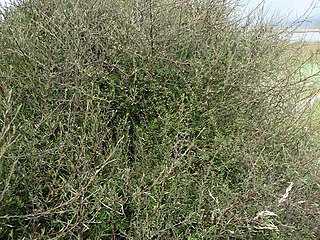
Plagianthus divaricatus or saltmarsh ribbonwood is a plant that is endemic to New Zealand. The Māori name is makaka. Other common names it is known by marsh ribbonwood, Houi and Runa.

Planotortrix flammea is a species of moth of the family Tortricidae. It is endemic to New Zealand.

Planotortrix notophaea, the blacklegged leafroller, is a species of moth in the family Tortricidae. It is endemic to New Zealand. It was also present near Sydney in Australia, but this population is thought to be extinct.

Epichorista lindsayi is a species of moth in the family Tortricidae. It is endemic to New Zealand. This species is classified as Nationally Endangered by the Department of Conservation.

Epichorista tenebrosa is a species of moth in the family Tortricidae. This species is endemic to New Zealand. It is found in Otago and has been collected in tussock grassland habitats. It is a late autumn emerging moth and adults are on the wing in February. It is classified as "At Risk, Relict'" by the Department of Conservation.

Tingena is a genus of the concealer moth family (Oecophoridae). This genus is endemic to New Zealand.

Notoreas arcuata is a species of geometer moth endemic to New Zealand. This species if found in the South Island and has been observed in the Saint Arnaud Range, around Arthur's Pass and in the Oteake Conservation Park. Larvae feed on species in the genera Kelleria and Pimelea. Adults are on the wing from December to February.
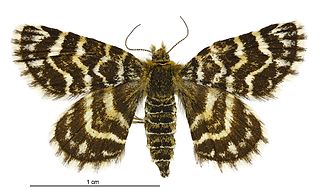
Notoreas hexaleuca is a species of moth in the family Geometridae. This species is endemic to New Zealand.

Notoreas ischnocyma is a species of moth in the family Geometridae. This species is endemic to New Zealand. This species is found in Canterbury and Otago.
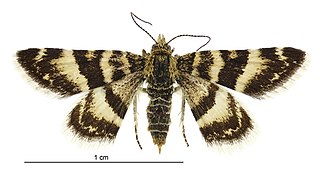
Notoreas ortholeuca is a species of moth in the family Geometridae. It is endemic to New Zealand.
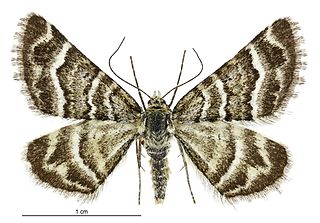
Notoreas paradelpha is a species of moth in the family Geometridae. It is endemic to New Zealand.

Physetica temperata is a species of moth of the family Noctuidae. It is endemic to New Zealand and found in the North Island and the top of the South Island in coastal areas. P. temperata is unlikely to be confused with other species in its range, even though it is not distinctively patterned. It is possible that males might be confused with males of P. homoscia but this latter species is much larger. P. temperata can be distinguished from P. caerulea as the former species has forewing veins that are marked black and a chequered forewing fringe. The adults of this species are on the wing from September to March. The life history of this species has not been well documented although it is thought that larval host species is Ozothamnus leptophyllus.
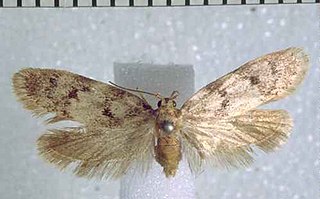
Leptocroca variabilis is a moth of the family Oecophoridae first described by Alfred Philpott in 1926. It is endemic to New Zealand. The classification of this moth within the genus Leptocroca is regarded as unsatisfactory and in need of revision. As such this species is currently also known as Leptocroca (s.l.) variabilis.




















